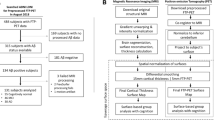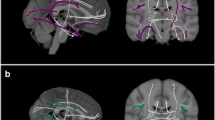Abstract
Cognitive deficits in behavioral-variant frontotemporal dementia (bvFTD) and AD are linked to frontal and temporal lobe gray matter (GM) pathology. The aim of this study was to assess the relative contribution of white (WM) and GM abnormalities to cognitive dysfunction in bvFTD and AD. Fractional anisotropy (FA) for the corpus callosum, cingulum (Cg), and uncinate fasciculus (Unc) was determined in 17 bvFTD and 10 AD patients who underwent neuropsychological testing. Regressions were performed to assess the relative contribution of WM and GM abnormalities to cognitive deficits. Multiple regression analysis revealed that in bvFTD, the left anterior Cg FA was related to executive function, the right anterior Cg FA to visual-spatial attention and working memory, the right posterior Cg to visual-constructional abilities and the left Unc FA to Modified Trails Errors. After adding corresponding GM volumes, the left anterior Cg FA, the right anterior cingulate FA, the right posterior cingulate FA and the left uncinate FA remained significant predictors of the cognitive tasks. In the AD group, the left posterior Cg FA and right descending Cg FA were related to visual recall performance but did not remain significant predictors when GM volumes were added to the regression. These results suggest that reduced integrity of specific WM tracts contribute to cognitive deficits observed in bvFTD after accounting for GM atrophy. In AD, memory impairment was related to WM tract injury but this relationship was no longer observed when GM volumes were included.


Similar content being viewed by others
References
Aguirre GK, Detre JA, Alsop DC, D’Esposito M (1996) The parahippocampus subserves topographical learning in man. Cereb Cortex 6:823–829
Avants BB, Cook PA, Ungar L, Gee JC, Grossman M (2010) Dementia induces correlated reductions in white matter integrity and cortical thickness: a multivariate neuroimaging study with sparse canonical correlation analysis. Neuroimage 50:1004–1016
Baron JC, Chetelat G, Desgranges B, Perchey G, Landeau B, de la Sayette V, Eustache F (2001) In vivo mapping of gray matter loss with voxel-based morphometry in mild Alzheimer’s disease. Neuroimage 14:298–309
Beaulieu C (2002) The basis of anisotropic water diffusion in the nervous system—a technical review. NMR Biomed 15:435–455
Beckmann CF, DeLuca M, Devlin JT, Smith SM (2005) Investigations into resting-state connectivity using independent component analysis. Philos Trans R Soc Lond B Biol Sci 360:1001–1013
Bor D, Duncan J, Lee AC, Parr A, Owen AM (2006) Frontal lobe involvement in spatial span: converging studies of normal and impaired function. Neuropsychologia 44:229–237
Boxer AL, Kramer JH, Du AT, Schuff N, Weiner MW, Miller BL, Rosen HJ (2003) Focal right inferotemporal atrophy in AD with disproportionate visual constructive impairment. Neurology 61:1485–1491
Braak H, Braak E, Kalus P (1989) Alzheimer’s disease: areal and laminar pathology in the occipital isocortex. Acta Neuropathol 77:494–506
Buckner RL, Snyder AZ, Shannon BJ, LaRossa G, Sachs R, Fotenos AF, Sheline YI, Klunk WE, Mathis CA, Morris JC, Mintun MA (2005) Molecular, structural, and functional characterization of Alzheimer’s disease: evidence for a relationship between default activity, amyloid, and memory. J Neurosci 25:7709–7717
Carter CS, Braver TS, Barch DM, Botvinick MM, Noll D, Cohen JD (1998) Anterior cingulate cortex, error detection, and the online monitoring of performance. Science 280:747–749
Chao LL, Schuff N, Clevenger EM, Mueller SG, Rosen HJ, Gorno-Tempini ML, Kramer JH, Miller BL, Weiner MW (2007) Patterns of white matter atrophy in frontotemporal lobar degeneration. Arch Neurol 64:1619–1624
Corballis PM, Funnell MG, Gazzaniga MS (2000) An evolutionary perspective on hemispheric asymmetries. Brain Cogn 43:112–117
Cowell SF, Egan GF, Code C, Harasty J, Watson JD (2000) The functional neuroanatomy of simple calculation and number repetition: a parametric PET activation study. Neuroimage 12:565–573
Delis D, Kaplan E, Kramer J (2001) The Delis-Kaplan executive function system. The Psychological Corporation, San Antonio
Desikan RS, Segonne F, Fischl B, Quinn BT, Dickerson BC, Blacker D, Buckner RL, Dale AM, Maguire RP, Hyman BT, Albert MS, Killiany RJ (2006) An automated labeling system for subdividing the human cerebral cortex on MRI scans into gyral based regions of interest. Neuroimage 31:968–980
Elderkin-Thompson V, Boone KB, Hwang S, Kumar A (2004) Neurocognitive profiles in elderly patients with frontotemporal degeneration or major depressive disorder. J Int Neuropsychol Soc 10:753–771
Goldman-Rakic PS (1988) Topography of cognition: parallel distributed networks in primate association cortex. Annu Rev Neurosci 11:137–156
Greicius MD, Srivastava G, Reiss AL, Menon V (2004) Default-mode network activity distinguishes Alzheimer’s disease from healthy aging: evidence from functional MRI. Proc Natl Acad Sci USA 101:4637–4642
Kaplan E (1983) Process versus achievement revisited. In: Wapner S, Kaplan B (eds) Toward a holistic developmental psychology. Lawrence Erlbaum, Hillsdale
Kaplan E, Fein D, Morris R, Delis D (1991) The WAIS-R as a neuropsychological instrument. Psychological Corporation, San Antonio
Kaplan E, Goodglass H, Wintraub S (1983) The Boston Naming Test. Lea and Febiger, Philadelphia
Kohler S, Black SE, Sinden M, Szekely C, Kidron D, Parker JL, Foster JK, Moscovitch M, Winocour G, Szalai JP, Bronskill MJ (1998) Memory impairments associated with hippocampal versus parahippocampal-gyrus atrophy: an MR volumetry study in Alzheimer’s disease. Neuropsychologia 36:901–914
Kramer JH, Jurik J, Sha SJ, Rankin KP, Rosen HJ, Johnson JK, Miller BL (2003) Distinctive neuropsychological patterns in frontotemporal dementia, semantic dementia, and Alzheimer disease. Cogn Behav Neurol 16:211–218
Lezak MD (2004) Executive functions and motor performance. In: Lezak MD (ed) Neuropsychological assessment, 4th edn. Oxford University Press, Oxford, pp 611–646
McKhann G, Drachman D, Folstein M, Katzman R, Price D, Stadlan EM (1984) Clinical diagnosis of Alzheimer’s disease: report of the NINCDS-ADRDA Work Group under the auspices of Department of Health and Human Services Task Force on Alzheimer’s Disease. Neurology 34:939–944
Mori S, Crain BJ, Chacko VP, van Zijl PC (1999) Three-dimensional tracking of axonal projections in the brain by magnetic resonance imaging. Ann Neurol 45:265–269
Neary D, Snowden JS, Gustafson L, Passant U, Stuss D, Black S, Freedman M, Kertesz A, Robert PH, Albert M, Boone K, Miller BL, Cummings J, Benson DF (1998) Frontotemporal lobar degeneration: a consensus on clinical diagnostic criteria. Neurology 51:1546–1554
Neumann M, Kwong LK, Truax AC, Vanmassenhove B, Kretzschmar HA, Van Deerlin VM, Clark CM, Grossman M, Miller BL, Trojanowski JQ, Lee VM (2007) TDP-43-positive white matter pathology in frontotemporal lobar degeneration with ubiquitin-positive inclusions. J Neuropathol Exp Neurol 66:177–183
Neumann M, Rademakers R, Roeber S, Baker M, Kretzschmar HA, Mackenzie IR (2009) A new subtype of frontotemporal lobar degeneration with FUS pathology. Brain 132:2922–2931
O’Sullivan M, Morris RG, Huckstep B, Jones DK, Williams SC, Markus HS (2004) Diffusion tensor MRI correlates with executive dysfunction in patients with ischaemic leukoaraiosis. J Neurol Neurosurg Psychiatry 75:441–447
Pa J, Possin KL, Wilson SM, Quitania LC, Kramer JH, Boxer AL, Weiner MW, Johnson JK (2010) Gray matter correlates of set-shifting among neurodegenerative disease, mild cognitive impairment, and healthy older adults. J Int Neuropsychol Soc 16:640–650
Park HJ, Kim JJ, Lee SK, Seok JH, Chun J, Kim DI, Lee JD (2008) Corpus callosal connection mapping using cortical gray matter parcellation and DT-MRI. Hum Brain Mapp 29:503–516
Rabinovici GD, Rascovsky K, Miller BL (2008) Frontotemporal lobar degeneration: clinical and pathologic overview. Handb Clin Neurol 89:343–364
Rabinovici GD, Seeley WW, Kim EJ, Gorno-Tempini ML, Rascovsky K, Pagliaro TA, Allison SC, Halabi C, Kramer JH, Johnson JK, Weiner MW, Forman MS, Trojanowski JQ, Dearmond SJ, Miller BL, Rosen HJ (2007) Distinct MRI atrophy patterns in autopsy-proven Alzheimer’s disease and frontotemporal lobar degeneration. Am J Alzheimers Dis Other Demen 22:474–488
Schroeter ML, Raczka K, Neumann J, von Cramon DY (2008) Neural networks in frontotemporal dementia—a meta-analysis. Neurobiol Aging 29:418–426
Seeley WW (2008) Selective functional, regional, and neuronal vulnerability in frontotemporal dementia. Curr Opin Neurol 21:701–707
Seeley WW, Crawford RK, Zhou J, Miller BL, Greicius MD (2009) Neurodegenerative diseases target large-scale human brain networks. Neuron 62:42–52
Seeley WW, Menon V, Schatzberg AF, Keller J, Glover GH, Kenna H, Reiss AL, Greicius MD (2007) Dissociable intrinsic connectivity networks for salience processing and executive control. J Neurosci 27:2349–2356
Sjobeck M, Elfgren C, Larsson EM, Brockstedt S, Latt J, Englund E, Passant U (2010) Alzheimer’s disease (AD) and executive dysfunction. A case-control study on the significance of frontal white matter changes detected by diffusion tensor imaging (DTI). Arch Gerontol Geriatr 50:260–266
Smith SM, Fox PT, Miller KL, Glahn DC, Fox PM, Mackay CE, Filippini N, Watkins KE, Toro R, Laird AR, Beckmann CF (2009) Correspondence of the brain’s functional architecture during activation and rest. Proc Natl Acad Sci USA 106:13040–13045
Song SK, Sun SW, Ramsbottom MJ, Chang C, Russell J, Cross AH (2002) Dysmyelination revealed through MRI as increased radial (but unchanged axial) diffusion of water. Neuroimage 17:1429–1436
Stuss DT, Alexander MP (2007) Is there a dysexecutive syndrome? Philos Trans R Soc Lond B Biol Sci 362:901–915
Wakana S, Jiang H, Nagae-Poetscher LM, van Zijl PC, Mori S (2004) Fiber tract-based atlas of human white matter anatomy. Radiology 230:77–87
Warrington EK, James M (1991) A new test of object decision: 2D silhouettes featuring a minimal view. Cortex 27:370–383
Wechsler D (1997) WAISIII and WMSIII—Wechsler Adult Intelligence Scale and Wechsler Adult Memory Scale, 3rd edn. The Psychological Corporation, San Antonio
Zhang Y, Schuff N, Du AT, Rosen HJ, Kramer JH, Gorno-Tempini ML, Miller BL, Weiner MW (2009) White matter damage in frontotemporal dementia and Alzheimer’s disease measured by diffusion MRI. Brain 132:2579–2592
Zhukareva V, Mann D, Pickering-Brown S, Uryu K, Shuck T, Shah K, Grossman M, Miller BL, Hulette CM, Feinstein SC, Trojanowski JQ, Lee VM (2002) Sporadic Pick’s disease: a tauopathy characterized by a spectrum of pathological tau isoforms in gray and white matter. Ann Neurol 51:730–739
Acknowledgments
We thank the participants and their families for their participation in this study. We thank Will Irwin for assistance with the figures. This publication was made possible by Grant numbers P01 AG019724 and P50 AG023501 from NIH National Institute on Aging. MCT is supported by Fonds de la recherche en santé du Québec.
Conflict of interest
None.
Author information
Authors and Affiliations
Corresponding author
Rights and permissions
About this article
Cite this article
Tartaglia, M.C., Zhang, Y., Racine, C. et al. Executive dysfunction in frontotemporal dementia is related to abnormalities in frontal white matter tracts. J Neurol 259, 1071–1080 (2012). https://doi.org/10.1007/s00415-011-6300-x
Received:
Revised:
Accepted:
Published:
Issue Date:
DOI: https://doi.org/10.1007/s00415-011-6300-x




